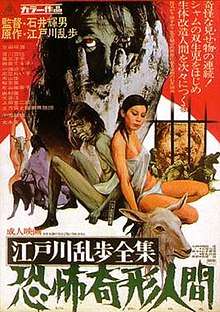Horrors of Malformed Men
Horrors of Malformed Men (江戸川乱歩全集 恐怖奇形人間, Edogawa Rampo Zenshū: Kyoufu Kikei Ningen) is a 1969 Japanese horror film directed by Teruo Ishii, who also co-wrote the film. It is based on the novels Strange Tale of Panorama Island (パノラマ島奇談, Panorama-tō Kidan) and The Demon of the Lonely Isle (孤島の鬼, Kotō no Oni) by Edogawa Rampo.
| Horrors of Malformed Men | |
|---|---|
 Theatrical release poster | |
| Directed by | Teruo Ishii |
| Produced by | Kanji Amao Shigeru Okada |
| Written by | Teruo Ishii Masahiro Kakefuda |
| Based on | Panorama Island Otan by Edogawa Rampo |
| Starring | Teruo Yoshida Teruko Yumi |
| Music by | Masao Yagi |
| Cinematography | Shigeru Akatsuka |
| Edited by | Tadao Kanda |
Production company | |
| Distributed by | Toei |
Release date |
|
Running time | 99 minutes |
| Country | Japan |
| Language | Japanese |
Plot
Hirosuke (Teruo Yoshida), a medical student with almost no recollection of his past, is trapped in an asylum, despite being perfectly sane. After escaping, and being framed for the murder of a circus girl, he spots the photo of a recently deceased man, Genzaburo Komoda, to whom he bears an uncanny resemblance. By pretending to have been resurrected, Hirosuke assumes the dead man's identity, fooling everyone, including Komoda's widow and mistress. Whilst at the Komoda household, Hirosuke recalls memories that convince him to travel to a nearby island, home of Jogoro, the web-fingered father of Genzaburo. Whilst on the island, Hirosuke not only discovers Jogoro's plans to build his 'ideal community' (by transforming perfectly normal humans into hideous freaks), but also the awful truth behind his own identity.
Cast
- Teruo Yoshida as Hirosuke Hitomi/Genzaburô Komoda
- Yukie Kagawa as Shizuko
- Teruko Yumi as Hideko/Hatsuyo
- Mitsuko Aoi as Toki Komoda
- Asao Koike
- Michiko Kobata as Chiyoko Komoda
- Minoru Ôki as Kogorô Akechi/Manservant
Release
Home media
On August 28, 2007, Synapse Films and Panik House gave Horrors of Malformed Men a mass-market release on region-1 DVD.[1][2]
Reception
Later reception
On Rotten Tomatoes, the film holds an approval rating of 100% based on 5 reviews, with a weighted average rating of 7.7/10.[3]
Donald Guarisco from Allmovie praised the film, calling it "a powerful, transgressive work that still packs a punch".[4] Stuart Galbraith IV from DVD Talk wrote, "With its odd mix of absurdist theater, surreal images, taboo-breaking depravity, and commercially driven exploitation, it's all over the stylistic map and not for all tastes, but a fascinating film on many levels".[5] Ian Jane from RockShockPop.com called it "A genuine holy grail of Japanese genre cinema", commending the film's choreography, cinematography, mood, and use of surreal imagery.[6] Arty Flores from HorrorNews.net liked the film, commending its bizarre and surreal imagery, while also noting that the film felt dated.[7]
Legacy
The film is considered a precursor to Toei's ventures into the "Pinky violent" style in the early 1970s.[8]
References
Notes
- Jane, Ian (August 22, 2007). "Horrors Of Malformed Men (DVD review)". dvdverdict.com. Archived from the original on October 13, 2007. Retrieved 2007-10-14. External link in
|publisher=(help) - Kehr, David. "New DVDs - The New York Times". New York Times.com. David Kehr. Retrieved 13 August 2018.
- "Edogawa ranpo taizen: Kyofu kikei ningen (Horrors of Malformed Men)(Horror of a Deformed Man) (1969) - Rotten Tomatoes". Rotten Tomatoes.com. Flixer. Retrieved 13 August 2018.
- Guarisco, Donald. "Horrors of Malformed Men (1969) - Teruo Ishii". Allmovie.com. Donald Guarisco. Retrieved 13 August 2018.
- Galbraith, Stuart. "Stuart Galbraith IV". DVD Talk.com. Stuart Galbraith IV. Retrieved 13 August 2018.
- Jane, Ian. "Rock! Shock! Pop! Forums - Cult Movie DVD & Blu-ray Reviews, Comics Books, Music And More! - Horrors Of Malformed Men". RockShockPop.com. Ian Jane. Retrieved 13 August 2018.
- Flores, Arty. "Arty Flores". HorrorNews.net. Arty Flores. Retrieved 13 August 2018.
- Macias, Patrick (2001). "Toei's "Pinky Violence" - Abnormal, Sensational, and Shameless". TokyoScope: The Japanese Cult Film Companion. San Francisco: Cadence Books. pp. 189–190. ISBN 1-56931-681-3.
External links
- Horrors of Malformed Men at AllMovie
- Horrors of Malformed Men on IMDb
- Horrors of Malformed Men at Rotten Tomatoes